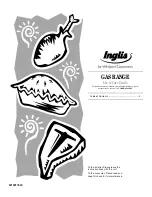
15
To Light a Burner:
Each burner control knob has a small diagram
next to it to tell you which burner it operates.
1. Push in on the knob and turn it counter-
clockwise to the HIGH position. The igniter for the
burner will spark repeatedly until it lights. The spark
makes a “clicking” sound. The burner should light
within four seconds.
2.
The flame should burn evenly around the perimeter
of the burner, except underneath each grate support
finger, where the flame height is reduced by Dacor’s
Smart Flame feature. A normal flame is steady and
blue in color. Foreign material in the gas line, especially
in new construction, may cause an orange flame during
initial operation. This will disappear with further use.
Small yellow tips on the ends of the flames are normal
when using LP gas.
3. If a burner does not ignite, the igniter continues to
spark or if the flame is not spread evenly around the
burner cap, see the Before You Call for Service section
on page 30.
4. Place the cooking utensil on the grate.
5.
Adjust the flame to the level necessary to perform the
desired cooking process.
IMPORTANT: When the cooktop is cool, the igniter may
continue to spark if the control knob is set to the LOW
position. The burner will stop sparking when warm. The
tendency to spark when cold can be reduced by operating
the burner at a higher flame setting for about 60 seconds.
After 60 seconds, lower the flame to cook. The burner will
also warm up faster if a utensil is placed on the grate. The
igniter will also spark automatically if the flame is distorted
by a draft or by the household ventilation system. Elimi-
nate any drafts or reduce the ventilation blower speed to
reduce this type of problem.
OFF
LOW
HIGH
Operating the Cooktop
Cooktop Tips
Dacor’s SimmerSear feature allows you precision control
of the flame. The larger the burner size, the wider the
range of control. See page 4 for the heat ranges of the
different burners.
• Food cooks just as quickly at a gentle boil as it does at
a vigorous, rolling boil. Maintaining a higher boil than
necessary wastes energy and cooks moisture, food
flavor and nutrients out of the food.
•
Use a low or medium flame when cooking with uten
-
sils that are poor conductors of heat, such as glass,
ceramic or cast iron. Reduce the flame until it covers
approximately 1/3 of the utensil diameter. Doing so
will ensure even heating and reduce the likelihood of
burning or scorching the food.
Содержание Discovery DYRP48DS
Страница 2: ...Copyright 2014 Dacor Inc All rights reserved...
Страница 9: ...7 Getting to Know Your Range 5 L K F E B H M N P J D C R G B A...
Страница 59: ......
















































